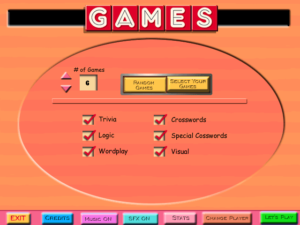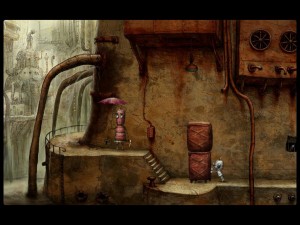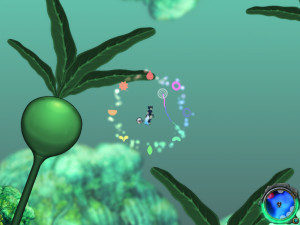Games Interactive: Main Menu
 So, let’s get right to it. This horse isn’t getting any deader. My criticism of Games Interactive, a work that no one cares about, begins at the main menu, which starts with a transition animation that’s out of sync with its sound effects. When I first played the game, I figured this was a symptom of my machine being too slow, but no, that’s just how it is. But that’s a trivial matter. The greater problem is that the whole design of the main menu is completely at odds with the game’s content.
So, let’s get right to it. This horse isn’t getting any deader. My criticism of Games Interactive, a work that no one cares about, begins at the main menu, which starts with a transition animation that’s out of sync with its sound effects. When I first played the game, I figured this was a symptom of my machine being too slow, but no, that’s just how it is. But that’s a trivial matter. The greater problem is that the whole design of the main menu is completely at odds with the game’s content.
There are a lot of puzzle games that let you pick individual puzzles out of a menu, and in most cases, their selection menus work pretty much the same way. You’re shown a bunch of levels, usually as names in a list or icons in a grid. You select one of them and the puzzle starts. When you’re finished with the puzzle, the game sends you either back to the selection menu or directly to the next puzzle in sequence. This is all fairly natural and intuitive, but it’s too simple for the makers of Games Interactive. Instead, you start with a menu that lets you choose a number of puzzles from 1 to 15, and whether you want to pick them from a list or let the game pick them at random. If you choose to pick them yourself, you go to a list where you check off as many checkboxes as you said you wanted puzzles, then press a “play” button to solve them in sequence. If you choose randomization, you can narrow the selection down by broad categories such as “Trivia”, “Logic”, and “Crossword”.
The default setting, which the menu reverts to on every visit, is to play six puzzles chosen at random from all categories. It’s inconceivable to me that anyone would actually want this. For one thing, I don’t see why you’d commit to solving six puzzles in a row instead of asking for one puzzle, solving it, and then seeing if you’re still in the mood for another. But even choosing one randomly-chosen puzzle is questionable. Sure, I can appreciate wanting a surprise, but it doesn’t exclude puzzles that you’ve already solved, and solving puzzles twice isn’t how puzzle games work. Also, there’s a great deal of variability in the size and length of these puzzles. Some are sets of trivia questions, which you just answer right or wrong, one after another, and finish with in a couple of minutes. Others are 25×25 “World’s Most Ornery” crossword puzzles, or entire collections of multiple Picross puzzles. Asking for six random puzzles is basically saying “I want to commit to a session lasting somewhere between fifteen minutes to several hours.”
In short, whoever designed this menu seems to have had a very different sort of game in mind, one composed of units that are uniformly bite-sized and replayable. The puzzles here are heterogeneous, and replayability is never a strong feature of puzzles. This is just one way that the makers of this game failed to handle their material well. I’ll describe more soon.
 Comments(5)
Comments(5)

